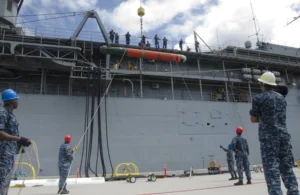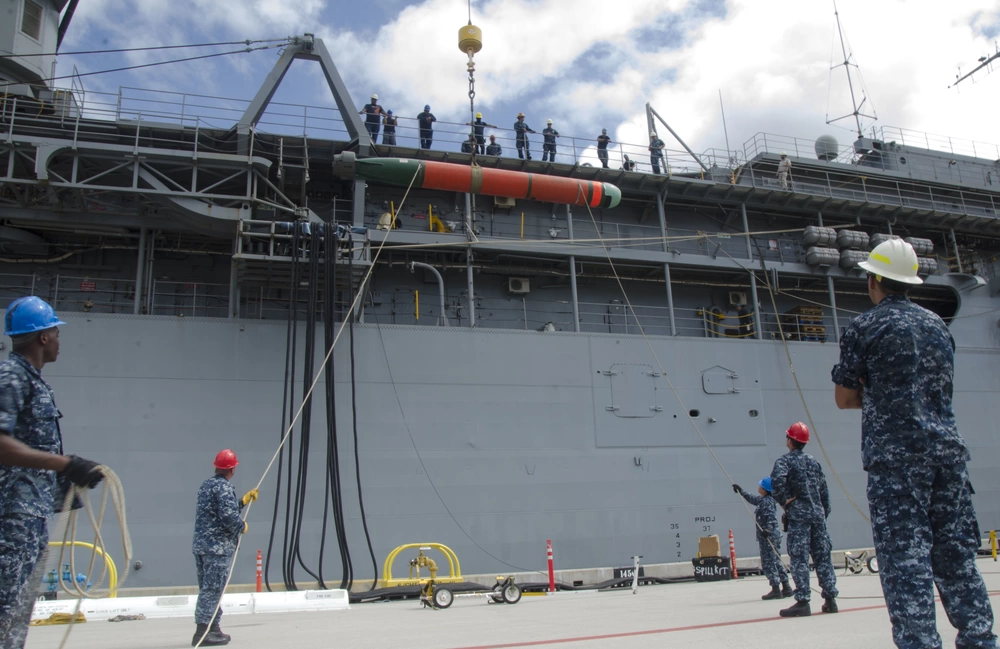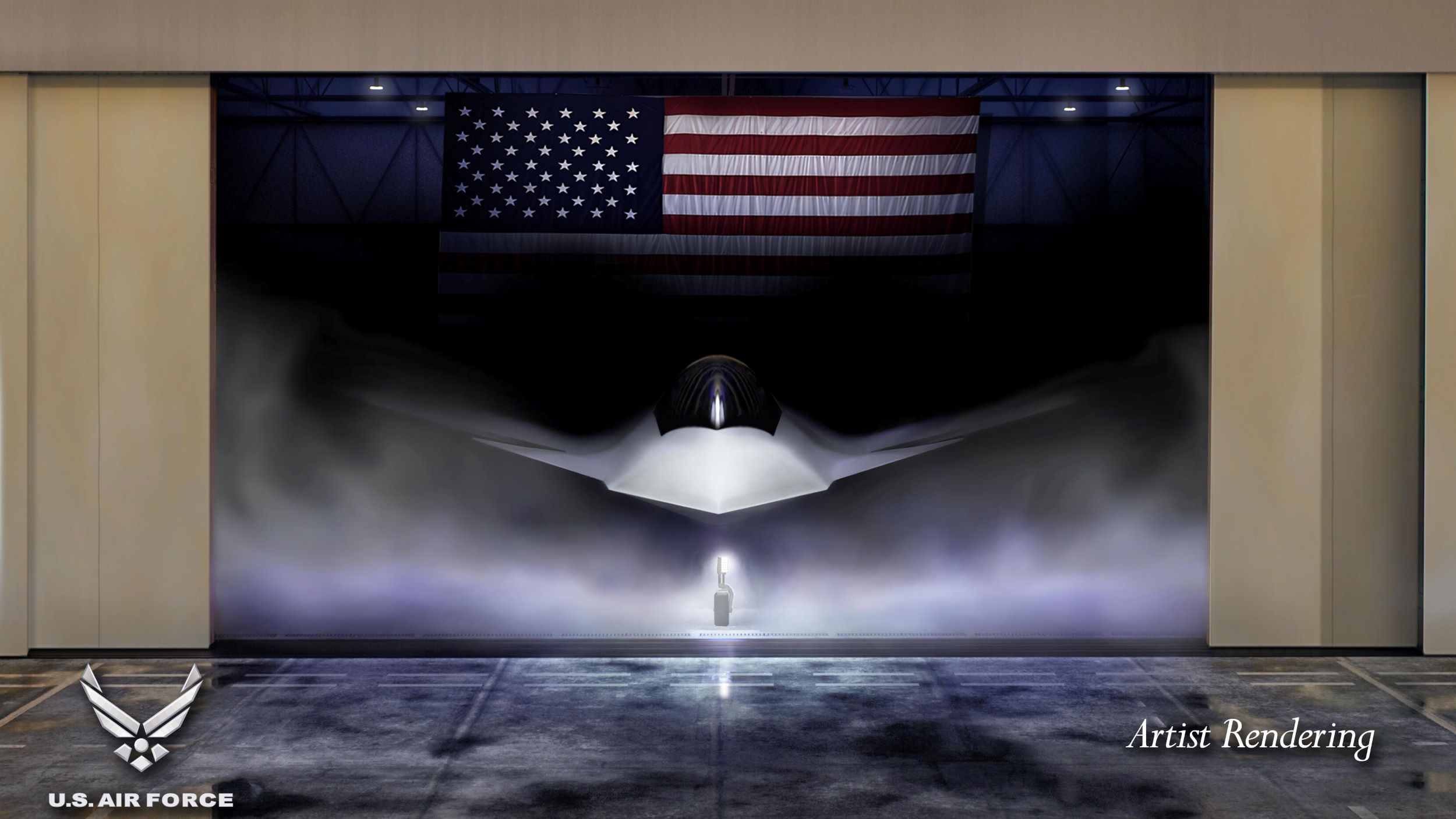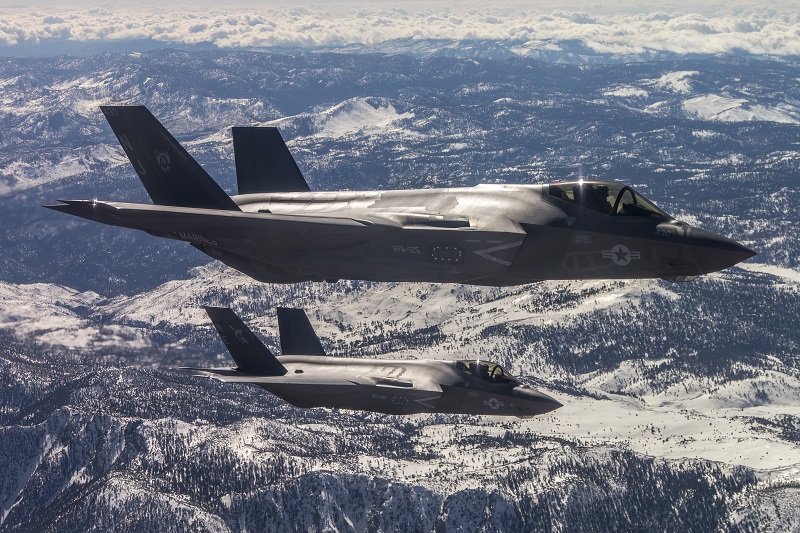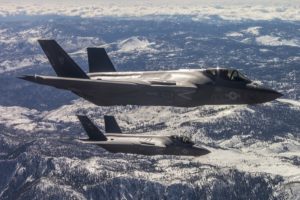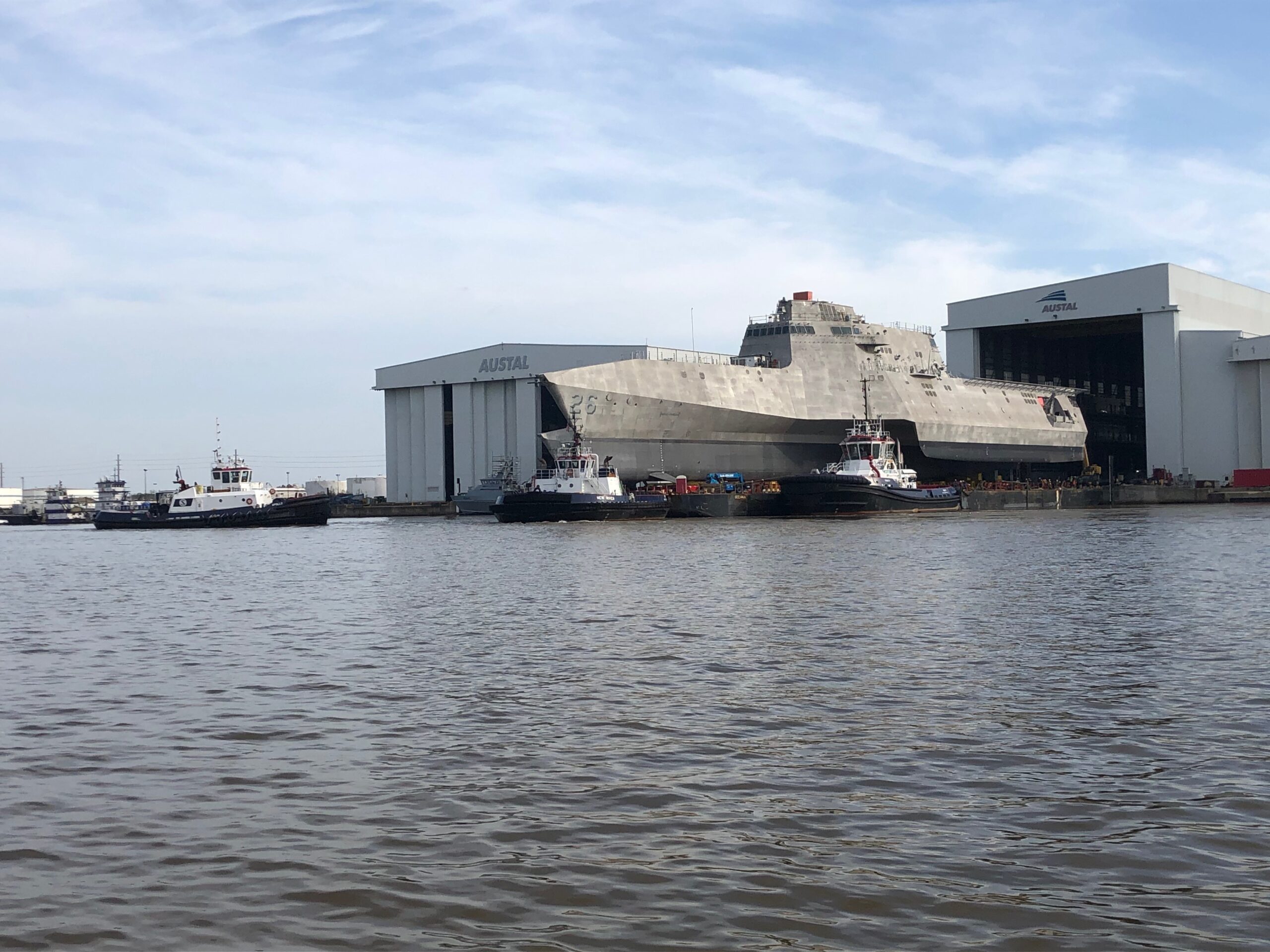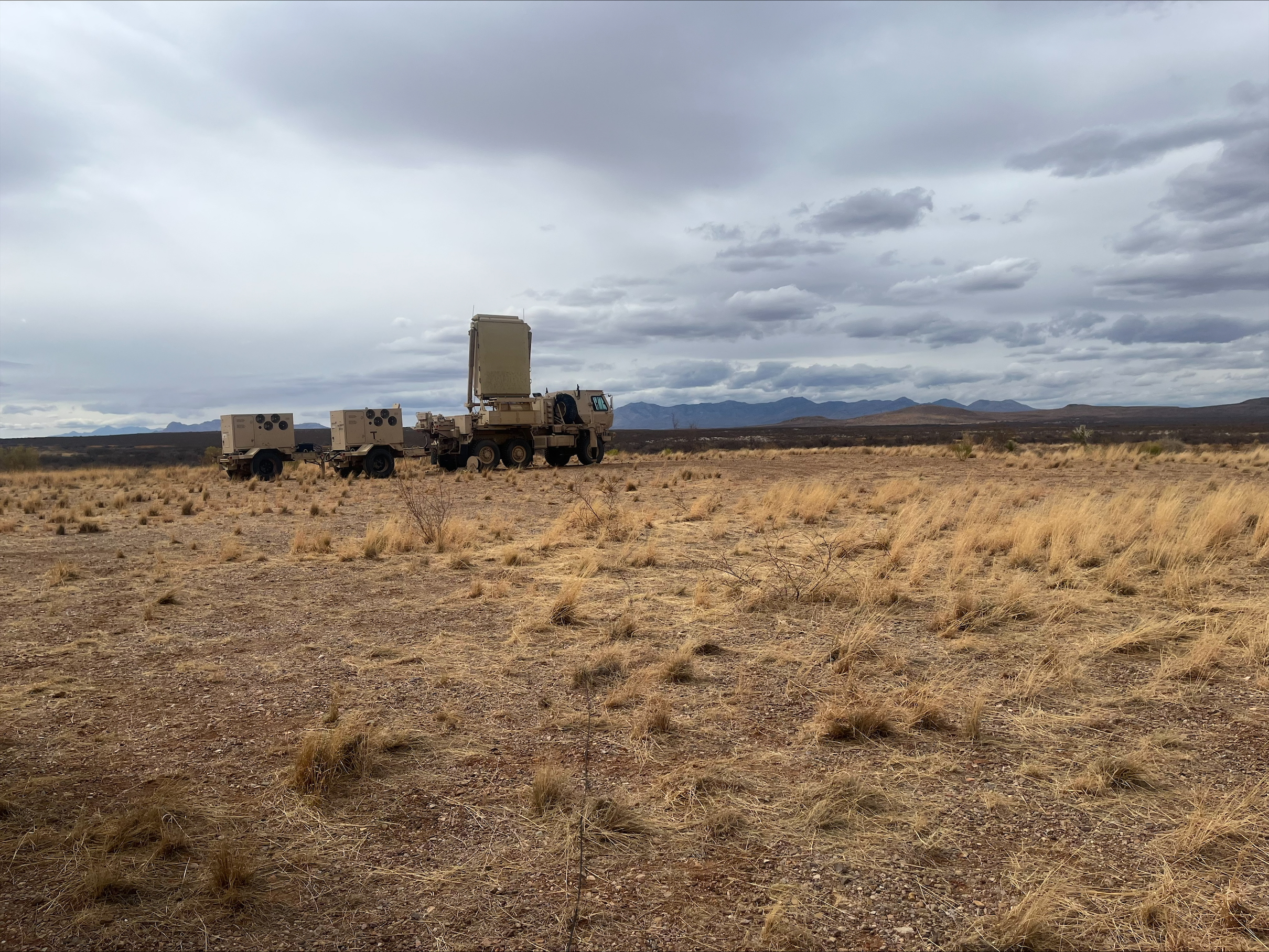$2 Billion. In the last few years, Congress has stepped up investments under the Defense Production Act, which Congress is to reauthorize this year. “In recent years, spurred by the COVID crisis and the war in Ukraine, there’s been fresh understanding of the importance of America’s domestic production capability, from medicine to minerals to munitions,” says Steve Morani, a senior executive service member performing the duties of DoD acquisition chief. “In response, over the past three fiscal years, nearly $2 billion in Defense Production Act funding has been obligated to enhance domestic industrial capacity for microelectronics, castings and forgings, batteries, solid rocket motors, energetics, and more.” Morani’s office is overseeing implementation of DoD’s first National Defense Industrial Strategy (NDIS), released by the Biden administration in January last year. NDIS “focuses on deterrence throughout the Indo-Pacific, and in doing so we are aligning industrial base investments to support priorities laid out by the President [Trump] and [Defense] Secretary [Pete] Hegseth,” Morani says. “America’s ability to deter China will depend in large part on production capacity, as well as innovating new capabilities and warfighting approaches, and right now we don’t have enough of it, at least for crucial weapons and supply chain.”
…Duffey Nomination
. Trump nominated Michael Duffey to be Pentagon acquisition chief on Dec. 22 last year, but, three months later, he has not had a hearing before the Senate Armed Services Committee (SASC). Duffey served as the associate director for national security programs in the White House Office of Management and Budget during Trump’s first term. Sen. Elizabeth Warren (D-Mass.), a SASC member, has asked for answers from Duffey on his role in freezing $250 million in congressionally approved aid to Ukraine in 2019.
MESA Combat ID. The Royal Australian Air Force (RAAF), Boeing, and Northrop Grumman “recently developed” and flight tested at RAAF Williamstown improved combat identification for Northrop Grumman’s Multi-Role Electronically Scanned Array (MESA), Northrop Grumman says. The advanced radar is carried on Australia’s Boeing-built E-7 Wedgetail airborne early warning aircraft. “Rather than simulating performance via a testbed aircraft, an in-service E-7 was utilized to perform these flight tests, reflecting the technical maturity and mission readiness of these capabilities,” Northrop Grumman says. “Flying in a true mission environment with these advanced capabilities for the first time, MESA identified air threats and securely processed key intel faster than ever before.” The U.S. Air Force is buying Wedgetail to help replace its 16 1970s-era Boeing E-3 AWACS planes.
NRO Proliferated Architecture. The National Reconnaissance Office’s (NRO) NROL-57 mission reached orbit after an early Friday NRO/U.S. Space Force Launch Delta 30 lift-off from Vandenberg Space Force Base, Calif., aboard a SpaceX Falcon 9 rocket. The launch is the eighth for the agency’s proliferated architecture. “About a dozen” NRO launches are scheduled this year–“approximately half” of which are to advance that proliferated architecture, the agency says.
Navy Training. HII on March 18 announced it won a $147 million contract to support shipboard and shore-based combat training services for the Navy. The five-year task order covers HII providing engineering support for every aspect of training systems under the U.S. Naval Surface Warfare Center Dahlgren Division, Dam Neck Activity (NSWCDD DNA), including hardware, software subsystems and elements. Tasks include integrated training system hardware and software installation, system certification and testing, troubleshooting, repair and lifecycle sustainment.
Oiler Fleet Task. The Navy announced its first-in-class fleet replenishment oiler, the USNS John Lewis (T-AO 205), became the first ship of the class to conduct a fleet task under the U.S. 3rd Fleet by refueling the USS Mustin (DDG-89) off the coast of Southern California on March 15. The Lewis was officially introduced into the fleet as a trained and certified ship on March 10 and is now fleet operational and set to depart on its first deployment later in 2025. This class can carry 162,000 barrels of diesel ship fuel, aviation fuel and dry stores cargo and is set to replace the aging Kaiser-class fleet of replenishment oilers.
Aussie LRASM. The Australian defense ministry announced its AGM-159C Long Range Anti-Ship Missile (LRASM) is ready for operational use following a successful live firing off the coast of California in February. Australia has allocated $561 million to acquire LRASM, which the ministry noted will increase the Royal Australian Air Force’s maritime strike range to over 370 km. The government said testing included validation of weapons preparation and loading, targeting and engagement. It also simulated a long-range maritime strike, supported by Australian E-7A Wedgetail and EA-18G Growler aircraft and a U.S. Navy P-8A Poseidon. This is part of a larger effort to invest $17.5 billion to $22 billion to enhance the military’s targeting and long-range strike capabilities.
New Hypersonic Facility. Kratos Defense & Security Solutions last week broke ground on a $50 million 68,000-square-foot office, laboratory, integration and test complex that will be used to integrate experimental payloads to increase the cadence of hypersonic flight testing. The Indiana Payload Integration Facility (IPIF) in Crane, Ind., is expected to achieve operational readiness by late 2026. The IPIF will support the Defense Department’s Multi-Service Advanced Capabilities Hypersonic Testbed program, which is aimed at creating an affordable flight-test bed to rapidly increase U.S. capacity to conduct hypersonic flight testing. Kratos in January nabbed a potential $1.5 billion award order for the MACH-TB 2.0 task area, which the company said provides a bridge between ground tests and system level flight tests.
Standardized Cyber Hunting. The Defense Innovation Unit last week said it awarded prototype contracts in February to Omni Federal, Parson Corp.’s Sealing Technologies, and World Wide Technology to deliver deployable Joint Cyber Hunt Kit (JCHK) that U.S. Cyber Command will use to hunt for advanced persistent threats. The rapidly deployable JCHK leverages commercial solutions that standardize cyber incident response kit across coalition and joint forces. DIU described the JCHK as a “mobile ‘security operations center in a box’ that can be transported by a nine-person team, anywhere in the world.” Britain and Australia also worked on the project.
…Hydrogen at the Edge. Prototype hydrogen generation systems have been delivered to two Marine Corps bases for operator testing of power produced at the tactical edge, DIU also said last week. NovaSpark Energy and Zepher Flight Labs in April 2024 were each awarded contracts under the Hydrogen at the Tactical Edge of Contested Logistics (HyTEC) to provide prototypes that produce hydrogen in austere environments. The prototype systems were delivered to units on Marine Corps Base Hawaii and Marine Corps Air Station Yuma to produce power that “will be used to operate fuel cell-powered UAS, small tactical electrical generators, and weather and communications balloons,” David Lorio, DIU HyTEC program manager, said in a statement. DIU, Marine Corps Expeditionary Energy Office, and the Naval Information Warfare Center Pacific are partners on the project.
Startup News. New startup Distributed Spectrum, which is developing software and sensors to “let anyone identify critical radio signals across defense missions,” last week announced an oversubscribed $25 million Series A funding round. Founded several months ago, the small New York City-based company said it closed more than $7 million in Defense Department contracts in 60 days. Distributed Spectrum said its machine learning-based products are being used in Ukraine to help front line forces identify threats.
…New Hivemind Partner. Expanding its roster of partners working with its Hivemind autonomy technology, Shield AI last week said it is working with Korea Aerospace Industries (KAI) to accelerate development of artificial intelligence pilots for aircraft. KAI will use Hivemind Enterprise “to rapidly verify its independently developed AI pilot technologies through various methods and elevate the to a world-class level,” KAI said. Shield AI’s Hivemind Enterprise includes an autonomy factory, middleware, an autonomy catalog, and mission control for developers to build their own autonomy solutions.
…New Software Security Firm. The venture capital firm Red Cell Partners last week publicly launched Hunted Labs, emerging from stealth with $3 million in pre-seed funding to bring AI-powered products that give organizations “end-to-end visibility into their software supply chains, allowing them to quickly identify, and eliminate, malicious threats,” the company said. Hunted Labs also has a $1.8 million Small Business Innovation Research Direct-to-Phase II contract with the Space Development Agency for the company to continue to develop Entercept, a product to give customers “command and control over their software supply chain,” it said.
Autonomy. Overland AI on March 18 announced its new SPARK offering, a “comprehensive autonomy upfit” that can turn any ground vehicle into an autonomous platform utilizing the company’s OverDrive software stack. “Designed for rapid deployment across existing military fleets, SPARK provides an immediate path to autonomy without the extended procurement timelines typically associated with new autonomous systems,” the company said in a statement. Overland AI said SPARK enables integration of the OverDrive autonomy software on an “ultra-compact compute module that fits in most vehicles.” “Its perception system uses LiDAR and stereo cameras to see through darkness, dust, and storms, while tracking movement via integrated GPS, IMU, and speed encoders. The system’s modular, drive-by-wire design allows for rapid installation with minimal modifications to the host vehicle, preserving manual control capabilities when needed,” Overland AI said.
Australia FMS. The State Department on March 18 said it has approved a potential $165 million foreign military sale with Australia for decoy flares, flare countermeasures, flare countermeasures, chaff cartridges and impulse cartridges. “The proposed sale will improve Australia’s capability to meet current and future threats by protecting and increasing aircraft survivability,” the Defense Security Cooperation Agency (DSCA) said in a statement. The contractors for the pending deal would include Kilgore Flares, Armtec Countermeasures, Alloy Surface Co. and CCI Capco.
Saudi Arabia FMS. The State Department on March 20 then announced a potential $100 million FMS case with Saudi Arabia for 2,000 Advanced Precision Kill Weapon Systems (APKWS) II all-up rounds. Along with the BAE Systems-supplied APKWS, Saudi Arabia would also receive support equipment, missile software and engineering and logistics support services. “The proposed sale will improve the Kingdom of Saudi Arabia’s capability to meet current and future threats and give it the ability to precisely engage targets with much less risk of collateral damage than other guided missile systems,” the DSCA said in a statement.
Shipbuilding Office. Ian Bennitt, a special assistant to President Trump and senior director for White House shipbuilding and maritime initiatives, is leading the administration’s new Office of Shipbuilding, Rep. Rob Wittman (R-Va.) said this week. Wittman, vice chair of the House Armed Services Committee, told reporters following remarks at this week’s McAleese Conference that Bennitt used to work on the HASC Seapower Subcommittee staff and previously spent time with the Shipbuilding Council of America. Trump, in his recent joint address to Congress, announced the new office and said it will focus on both military and commercial shipbuilding, to include offering tax incentives to help improve domestic capacity.
IBCS Software. Ultra Intelligence & Communications said on March 19 it has received a five-year, $86.8 million Other Transaction Authority agreement from the Army to deliver advanced software prototypes for the Northrop Grumman-built Integrated Battle Command System mission command systems that will be deployed in support of Guam defense operations. “Ultra I&C will integrate its ADSI software platform, providing comprehensive Link-16 interoperability, MIL-STD and tactical data link interfaces and force operations data within the IBCS architecture,” the company said in a statement. “Additionally, the company will deliver seamless Link-16 interoperability capabilities alongside state-of-the-art artificial intelligence and machine learning integration to meet emerging battlefield requirements.”
Wicker/Rogers’ Concern. Sen. Roger Wicker (R-Miss.) and Rep. Mike Rogers (R-Ala.), leaders of the Senate and House Armed Services Committee, issued a joint statement on March 19 stating they’re “very concerned” with reports the Trump administration may be considering unilateral changes “on major strategic issues, including significant reductions to U.S. forces stationed abroad, absent coordination with the White House and Congress.” The statement followed an NBC News report on March 19 that Trump was considering withdrawing the U.S. from its role as NATO’s Supreme Allied Commander Europe and canceling plans to modernize U.S. Forces Japan. “We support President Trump’s efforts to ensure our allies and partners increase their contributions to strengthen our alliance structure, and we support continuing America’s leadership abroad. As such, we will not accept significant changes to our warfighting structure that are made without a rigorous interagency process, coordination with combatant commanders and the Joint Staff, and collaboration with Congress,” Wicker and Rogers said.
Antitrust Approvals. New space economy company Redwire Corp. last Friday said it has received all regulatory approvals for its pending $925 million acquisition of Edge Autonomy, which would give it a play in unmanned aircraft systems. U.S, Canadian, Latvian, and United Kingdom regulators all granted their approvals. The deal is expected to close in the second quarter of 2025, pending approval by Redwire’s stockholders.
